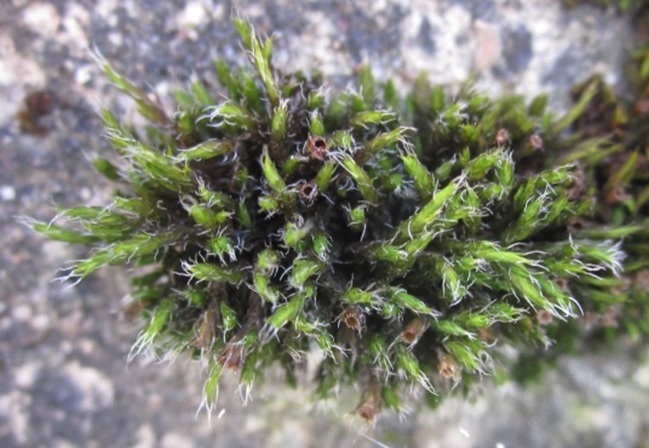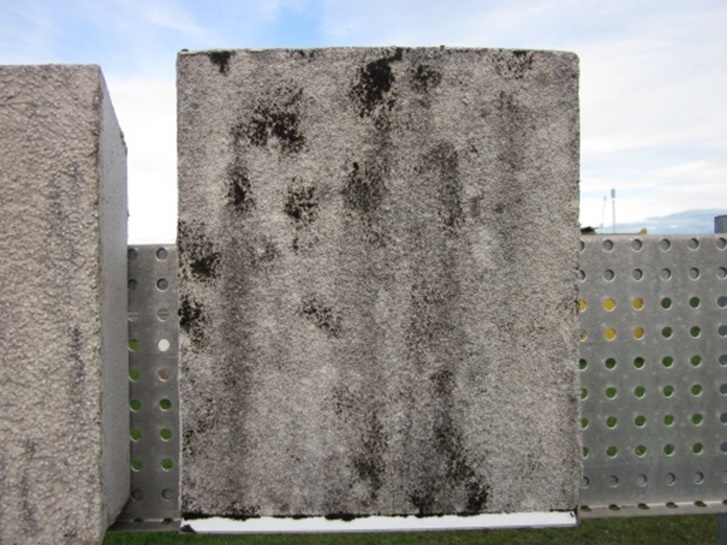Back in 2014, staff in the molecular lab and herbarium at RBGE greatly enjoyed a three-week visit from Austrian Dr Wolfgang Hofbauer. With funding from the EU SYNTHESYS programme, Wolfgang, employed by the Fraunhofer Institute for Building Physics, was here to investigate mosses of modern building surfaces. He brought with him interesting chocolate, a taste for weird sodas, his wife and their son. While his family enjoyed the ambience of Edinburgh, strolling in the city and garden, Wolfgang was hard at work sampling mosses that he had collected in Austria, Germany and the UK, and comparing them to collections in our herbarium.
Building walls are a bit like cliffs, harsh habitats where only the very hardy can survive, with little shelter, periods of intense light and restricted water availability. Plants that do manage to establish there are frequently stunted individuals, with atypical morphology, which do not always possess the full range of characters (e.g. bryophyte sporophytes and spores) that may be required to identify species reliably. The group of mosses that Wolfgang is particularly interested in, Schistidium, grow slowly on buildings, with frequently incomplete development. In the past, collections of these mosses have mostly been named as Schistidium apocarpum, a species that is thought to be widespread and common. Wolfgang’s work involves comparing well-developed samples of Schistidium species from our herbarium with the stunted individuals he has been collecting from walls, cement and tarmac, both by looking at the plants’ morphological features, and by comparing standard regions of their DNA (plant DNA barcoding). An important part of this work is the development of a “reference” set of sequences from fresh and herbarium samples that possess a full range of morphological characters, allowing them to be identified reliably to species. Many of the Schistidium collections in Edinburgh have been revised by one of the most respected taxonomists working on the group, Dr Hans Blom, allowing us to generate DNA sequences from some of the plants that Blom has studied and named; these should correspond to Blom’s taxonomic ideas about species in Schistidium. This standard reference set will enable future identification of stunted and dwarfed specimens from building substrates, by comparing their DNA sequences to the standards.
From the work we conducted with Wolfgang during his visit to RBGE, we could see that the first Schistidium colonisers on modern building surfaces actually include several distinct genetic lineages. These lineages have been sampled from several locations around Europe, but in order to define geographic patterns and to evaluate morphological characters, we need more intense sampling, which will allow us to discuss the diversity and ecology of Schistidium colonisers on modern building surfaces. There are two practical outcomes of isolating the lineages that occur on these surfaces. First, if we can identify dominant species, then we may be able to identify selective biocontrol of moss growth on building surfaces, which can be regarded as unsightly. Second, and in contrast, some of these lineages may actually be adapted to grow on modern building surfaces – and therefore could be used for moss gardening. This could be beneficial for insulation purposes, to reduce air pollution and climate gases (CO2 scavenging), to increase biodiversity within an area, and, last but not least, for aesthetic purposes: greening cities and visually breaking up expanses of concrete.
(This Botanics Story has been cowritten by Laura Forrest and Wolfgang Hofbauer.)
Wolfgang Karl Hofbauer, Laura Lowe Forrest, Peter M. Hollingsworth, Michelle L. Hart. 2016. Preliminary insights from DNA barcoding into the diversity of mosses colonising modern building surfaces. Bryophyte Diversity and Evolution 38(1)



Gary Powell
I would be very interested in knowing which species are found on particular substrates eg. Asphalt, concrete, the various materials used for roofing, car paints,
rubber seals, types of wood product and all the various stone and brick building materials. Each will have a particular pH & surface texture & other qualities which a variety of species will each prefer or avoid. Also which species is found on the most types of substrate & which tolerate the greatest ranges of pH ?
Is there anything published that will give me this I formation ?
Laura Forrest
Gary, the lineages of Schistidium that we were identifying don’t seem to be quite as specific as that; if you access the scientific paper, through the link I’ve just added to the article, you can see the substrates are marked onto the relationship diagrams (phylograms) – there will also be a few highly generalist weedy moss species that can occur on a very wide range of habitats (including very modern ones, like car paints and rubber seals).